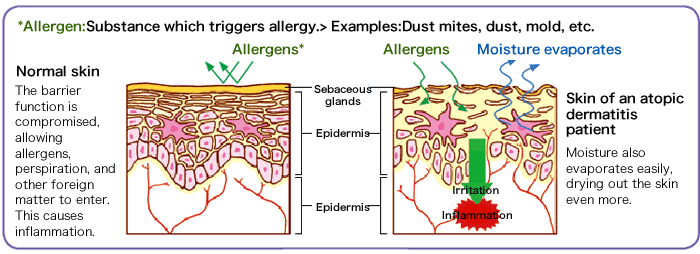Atopic dermatitis
Last updated on: 8 April 2019 | Released on: 21 April 2017
What is atopic dermatitis?
Atopic dermatitis is a condition in which an itchy rash appears on the face and body. This rash is chronic and goes through periods of remissions and exacerbations.
The skin dries out and its barrier function is compromised. This allows gaps to form on the skin’s surface, which makes it easier for various bacteria, irritants, allergens etc. to enter the skin. This results in inflammation.

(Source: Environmental Restoration and Conservation Agency’s “Sukoyaka Life (Healthy Life)” Vol. 43)
Atopic dermatitis: Characteristics and symptoms
- Skin is dry overall.
- Rashes often appear on both sides of the body symmetrically.
- Rashes tend to manifest in different areas depending on the age of the person.
- Infancy: Rashes are often found on the scalp, cheeks, mouth area, neck, and/or behind the ears, spreading to the torso and limbs when exacerbated
- Early childhood and school age: Neck and joints, such as inside and outside of elbows and knees
- Puberty and adulthood: Upper body (face, neck, chest, back)
- Itchy rashes persist over the long term (at least 2 months in infants, at least 6 months for other age groups).
Skin symptoms have various stages. It may start out as dry, scaly skin, which may become hardened and thickened, or develop reddening, swelling, or “weeping” of fluid when the skin is broken.
Treatment
To improve atopic dermatitis, it is necessary to relieve inflammation and restore the skin’s barrier function. Treatment of atopic dermatitis consists of standard therapy (the 3 pillars of treatment) scientifically proven to be effective.
The 3 pillars of treatment
- Skincare: Keeping the skin clean and preventing dryness (moisturizing)
- Medication: Applying topical (external) medication to the skin to control inflammation
- Management of exacerbating factors: Controlling perspiration, dust mites, and other factors which may worsen symptoms
Medication (topical medicine)
Topical (applied externally) steroids and tacrolimus ointment are used to control the skin inflammation associated with atopic dermatitis. Topical steroids are classified into 5 categories according to their potency, or strength. Different steroids are used for different parts of the body and for different degrees of severity.
Some people may hesitate to use these medications because of anxiety or negative perceptions – they may be afraid of possible side effects or other harm to their health. Others may have had frustrating experiences with medications in the past, feeling the medicine was not as effective as they expected or even seemed to worsen their condition. In such cases, these people may lose their trust in the medicine or their doctor, and stop using the medicine or even discontinue treatment altogether.
However, in the majority of cases, the medicine itself is not to blame. The reason for non-improvement is usually that the treatment is not strong enough to control the skin inflammation completely: The potency of the medicine may not be correctly matched with the symptoms, or the amount or method of application may not be correct.
Factors which worsen the symptoms may also differ according to the patient’s age and physical traits. Patients can help prevent their symptoms from worsening by keeping track of which kinds of situations seem to exacerbate their condition.
For best results, the patient should take a positive, persevering approach to treatment: Consult with the doctor to find the best potency (strength) of topical medication to match your skin symptoms, and make sure you use the medication correctly (what to use, how much to use, on which body parts, when, how frequently, how to apply, etc.).

